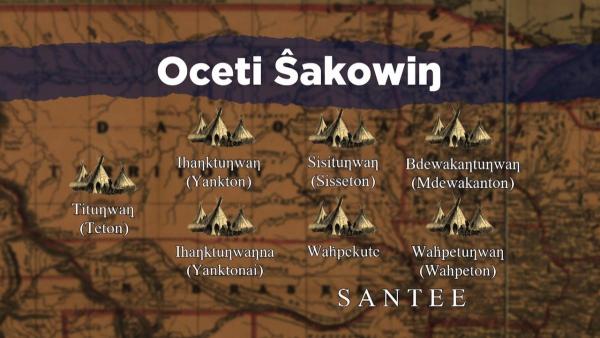 Mitakuye oyasin: "All are related"
Mitakuye oyasin: "All are related"
From Oceti Šakowiŋ: The Seven Council Fires. MNHS Collections.
Historically, there were seven major divisions — "council fires" — of the Dakota, each with a distinct but similar culture. Bdewakaŋtoŋwaŋ, The Spirit Lake People (Mdewakanton); Waĥpekute, The Shooters Among the Leaves People (Wahpekute); Waĥpetoŋwaŋ, The People Dwelling Among the Leaves (Wahpeton); and Sisitoŋwaŋ, People of the Fish Village(s) (Sisseton), are referred to as the Santee or Eastern Dakota. Ihaŋktoŋwaŋ, Dwellers at the End (Yankton); and Ihaŋktoŋwaŋna, Little Dwellers at the End (Yanktonai), are referred to as the Western Dakota or often as the Nakota; and the Tituŋwaŋ, Dwellers on the Plains (Teton) are called Lakota. The historic alliance of these divisions has been known variously over time as the Sioux, the Great Sioux Nation, or Oceti Ŝakowiŋ, the Seven Council Fires. Today Dakota, Lakota, and Nakota tribal governments and communities are located in Minnesota, North and South Dakota, Nebraska, and Montana in the United States, and Alberta, Manitoba and Saskatchewan in Canada.
Learn more by hearing oral histories of members of Dakota communities.
Knudson, Nicolette, Jody Snow, and Clifford Canku. Beginning Dakota:Tokaheya Dakota Iapi Kin : 24 Language and Grammar Lessons with Glossaries. St. Paul, MN: Minnesota Historical Society Press, 2011.
Websites
Primary
The American Indian Research Project. University of South Dakota.
The U.S.-Dakota War of 1862 Oral History Project. Minnesota Historical Society.
Secondary
Knudson, Nicolette, Jody Snow, and Clifford Canku. Beginning Dakota:Tokaheya Dakota Iapi Kin : 24 Language and Grammar Lessons with Glossaries. St. Paul, MN: Minnesota Historical Society Press, 2011.
Westerman, Gwen, and Bruce M. White. Mni Sota Makoce: The Land of the Dakota. St. Paul, MN: Minnesota Historical Society Press, 2012.




